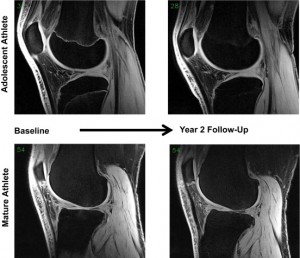I wrote about CHOP before here.
Here’s some new studies about CHOP and longitudinal bone growth:
“Pseudoachondroplasia (PSACH) is an autosomal dominant skeletal dysplasia caused by mutations in cartilage oligomeric matrix protein (COMP) and characterised by short limbed dwarfism and early onset osteoarthritis. Mouse models of PSACH show variable retention of mutant COMP in the ER of chondrocytes, however, in each case a different stress pathway is activated and the underlying disease mechanisms remain largely unknown. T585M COMP mutant mice are a model of moderate PSACH and demonstrate a mild ER stress response. Although mutant COMP is not retained in significant quantities within the ER of chondrocytes, both BiP and the pro-apoptotic ER stress-related transcription factor CHOP are mildly elevated, whilst bcl-2 levels are decreased, resulting in increased and spatially dysregulated chondrocyte apoptosis. To determine whether the abnormal chondrocyte apoptosis observed in the growth plate of mutant mice is CHOP-mediated, we bred T585M COMP mutant mice with CHOP-null mice to homozygosity, and analysed the resulting phenotype. Although abnormal apoptosis was alleviated in the resting zone following CHOP deletion, the mutant growth plates were generally more disorganised. Furthermore, the bone lengths of COMP mutant CHOP null mice were significantly shorter at 9 weeks of age when compared to the COMP mutant mice, including a significant difference in the skull length.{So you don’t want to inhibit CHOP is you want to grow taller} Overall, these data demonstrate that CHOP-mediated apoptosis is an early event in the pathobiology of PSACH and suggest that the lack of CHOP, in conjunction with a COMP mutation, may lead to aggravation of the skeletal phenotype via a potentially synergistic effect on endochondral ossification. ”
So CHOP increasing apoptosis is critical for optimal longitudinal bone growth.
“CHOP can be activated via the PERK and ATF6 unfolded protein response (UPR) pathways and acts to decrease the levels of the anti-apoptotic protein bcl-2, which subsequently renders the cells more susceptible to programmed cell death”
“In contrast, the length of the skull, which is formed through a combination of endochondral and intramembranous ossification, was 4.7% shorter in CHOP null mice at 9 weeks of age when compared to the wild type controls”
There was no significant differences between bone length in pelvic, femur, and tibia bone but there didn’t seem to be any trends either way. But at 9 weeks it’s possible that CHOP null mice were longer than mice were CHOP was present in the other bones.
CHOP deletion exaserbated dwarfism though.

